How to Interpret Seismic Parameters?
How to Interpret Seismic Parameters?
WONG Cheuk-yiu Lillian and LAM Ching-chi Queenie
May 2023
"Initial analysis from the Hong Kong Observatory indicated that an earthquake of magnitude 6.5 has occurred at 5:25 a.m. on 26 February 2023 (Sunday) (Hong Kong Time) in New Britain Region, Papua New Guinea. The epicentre is located near ..."
Many of us notice about earthquake messages in our daily life. Earthquake is a physical phenomenon of crustal movement which is closely related to geological structures. To describe an earthquake, the main parameters include the origin time, epicentre (location of the vertical projection of the epicentre to the ground; see Figure 1 (a)), magnitude (energy released from the earthquake source), focal depth (distance between hypocentre and epicentre ; see Figure 1(a)), and focal mechanism (types of rupture and slip that occur during an earthquake), etc. Most of the epicentres are located at fault zones. Most of them are shallow earthquakes with a focal depth of less than 70 kilometres, generally about 5-20 kilometres deep. About 3% are deep earthquakes with a focal depth of 300 – 700 km. The global and local seismic networks collects real-time seismic waves. Seismic parameters can then be analysed from a sufficiently large number of seismic waveform data (see Figure 1 (b) and Figure 2).
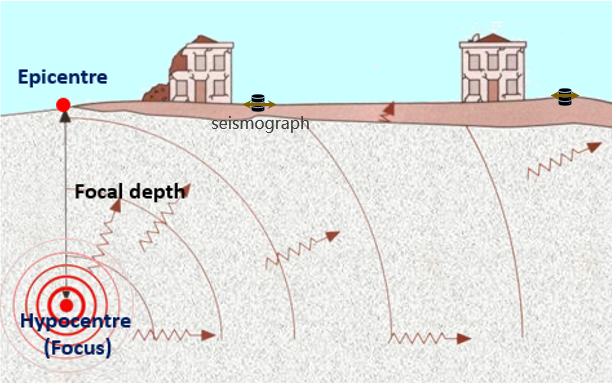
Figure 1 (a)
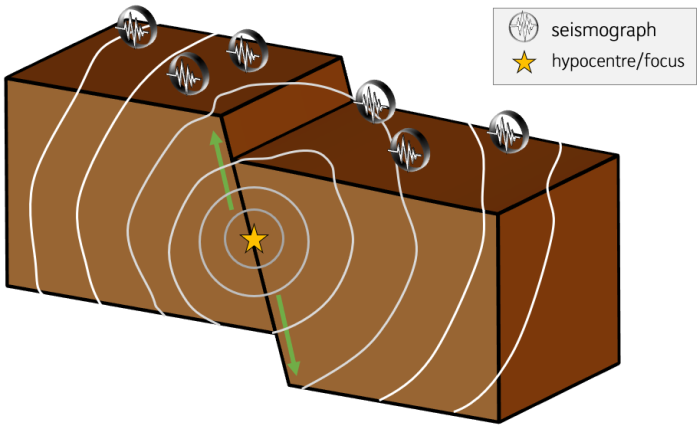
Figure 1 (b)
Figure 1 Schematic diagram showing (a) a number of earthquake parameters; (b) seismic waves emitted from the hypocentre travelling in all directions. The crustal movement can be recorded by seismographs at various locations on the ground.
Figure 1 Schematic diagram showing (a) a number of earthquake parameters; (b) seismic waves emitted from the hypocentre travelling in all directions. The crustal movement can be recorded by seismographs at various locations on the ground.
Earthquake intensity, unlike magnitude, is a measure of shaking at a location which indicates the impact or damaging effect of an earthquake. It is determined from reported effects of the tremor on human beings, furniture, buildings, geological structure, etc. It can also be estimated from local seismic accelerometer data. Many places, including Hong Kong, have adopted the Modified Mercalli Scale (MMS) to classify earthquake effects. In general, the closer the distance to the epicentre, the greater the impact of the earthquake and the higher the intensity. Over the past few decades, as technology has improved and the population has increased, seismographs have become denser, allowing us to better monitor earthquakes and record more earthquakes.
Seismic waves
When an earthquake occurs, different types of seismic waves will propagate through the Earth’s interior and along the surface. Due to their different propagation speeds, they will arrive at the same place at different times. Seismographs on the ground can record and show them in sequence (see Figure 2). Seismic waves are mainly divided into the following two categories:
1. Body waves: Waves that can propagate in any direction in the inner space of the Earth, including longitudinal waves (or P waves), and transverse waves (or S waves). P waves travel faster than S waves, so P waves are usually the first to appear on a seismogram.
2. Surface wave: The wave that only propagates along the surface of the Earth. Its amplitude is generally larger than the body wave. Its speed is slower than the body wave.
2. Surface wave: The wave that only propagates along the surface of the Earth. Its amplitude is generally larger than the body wave. Its speed is slower than the body wave.
Earthquake monitoring agencies can quickly estimate the location and magnitude of earthquakes by analysing the waveform data recorded by global and local seismograph networks. As the amplitude of the S wave is normally larger than that of the P wave, and the horizontal vibration of the S wave poses a greater threat to the structure of buildings.
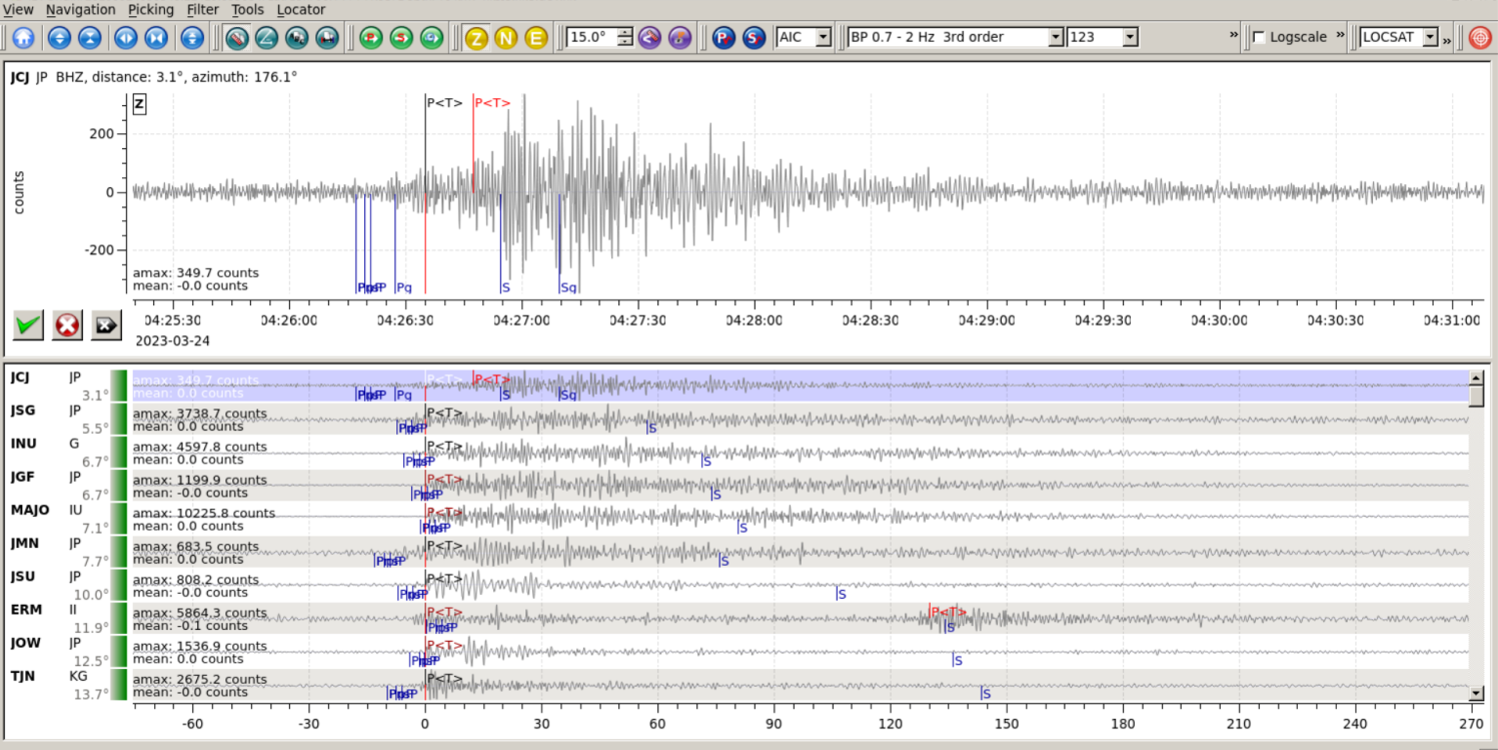
Figure 2 Analysis of seismic wave data.
Earthquake magnitude
Magnitude was proposed by American seismologist Charles Richter in 1935. Magnitude is a grading system used to describe the severity of an earthquake. It is related to the energy released during an earthquake. The higher the magnitude, the greater the damage generally caused. In addition to the familiar Richter Scale for earthquakes, seismologists have defined various magnitude types over the past few decades to compensate for the shortcomings of the existing system. There are mainly four types of earthquake magnitude commonly used in various places at present. They are Richter magnitude/local magnitude ML, surface-wave magnitude MS, body-wave magnitude mb/mB) and moment magnitude Mw.
The Richter Scale ML
Richter was the first seismologist to propose the classification of earthquakes based on the amplitude of seismic waves recorded by seismographs. The Richter Scale can only be applied to earthquakes within a range of several hundreds kilometres recorded by short-period seismographs, hence the term "local magnitude".
Richter was the first seismologist to propose the classification of earthquakes based on the amplitude of seismic waves recorded by seismographs. The Richter Scale can only be applied to earthquakes within a range of several hundreds kilometres recorded by short-period seismographs, hence the term "local magnitude".
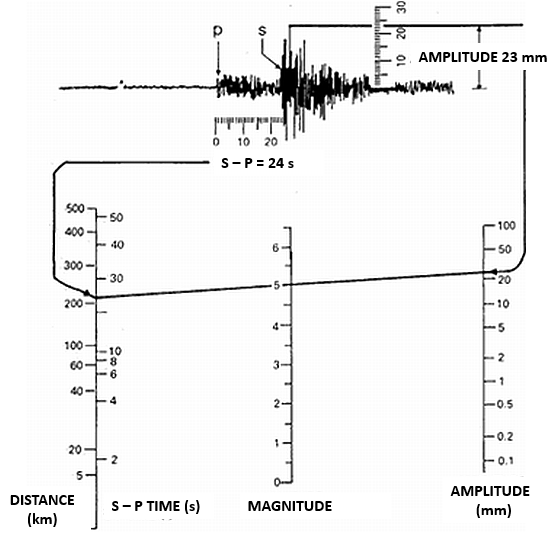
Figure 3 A diagram showing how to use seismic waves to estimate earthquake magnitude in the Richter Scale. Analyse the S-P wave travel time difference and maximum amplitude of seismic waves, draw a point at the corresponding position in each ruler, and then use a straight line to connect the two points, the intersection point of the straight line and the magnitude ruler gives the magnitude. (Note: S wave travels slower than P wave, so the epicentral distance can be estimated by using the difference between arrival times of the two waves at the seismograph.)
Surface wave magnitude MS and body wave magnitude mb / mB
Short-period waves attenuate faster with the epicentral distance. ML is not sensitive to far-field earthquakes. Beno Gutenberg proposed to use surface waves detected by long-period seismographs with a longer period (18 to 22 seconds) to calculate earthquake magnitude, named this as surface-wave magnitude MS.
Short-period waves attenuate faster with the epicentral distance. ML is not sensitive to far-field earthquakes. Beno Gutenberg proposed to use surface waves detected by long-period seismographs with a longer period (18 to 22 seconds) to calculate earthquake magnitude, named this as surface-wave magnitude MS.
As surface waves propagate along the Earth’s surface, the surface wave magnitude is only applicable to shallow earthquakes. So how can we determine the magnitude of deep earthquakes? Gutenberg and Richter noticed that body waves are clearly visible in all earthquake records. They proposed to determine the magnitude based on body waves with short period (up to several seconds in general), mb, and medium/long period (up to ten or several tens seconds), mB.
Magnitude saturation
Each of the above three types of earthquake magnitude reflects the energy of seismic waves of different periods. However, rocks in large earthquakes take a long time to rupture, and the period of seismic waves is often longer than these periods. Taking the great earthquake in Japan on 11 March 2011 as an example, the rupture time was inferred to be close to 3 minutes. The types of magnitude mentioned above have upper limits, and they all underestimate the magnitude of large earthquakes. This phenomenon is called "magnitude saturation", and the upper limit is "saturation magnitude". The shorter the period of the seismic waves used to calculate the magnitude, the earlier the underestimation will occur. Figure 4 and Table 1 respectively show the relationship of different types of magnitude and the saturation magnitude of each type.
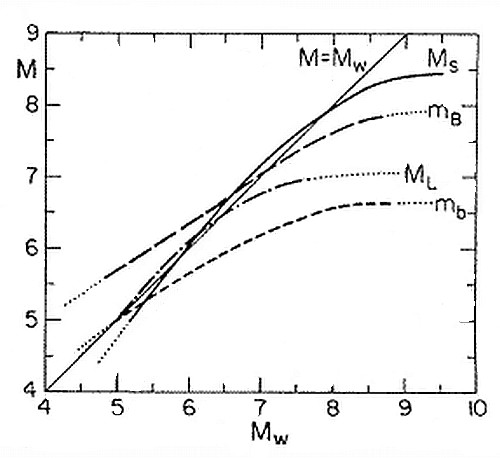
Figure 4 An approximate relationship of different types of magnitudes (moment magnitude Mw, surface-wave magnitude MS, body-wave magnitude mb/mB, local magnitude ML) inferred from historical data. (Source: Technophysics, 1983).
| Earthquake magnitude | Saturation magnitude |
|---|---|
| mb | 6.5 |
| ML | 7.0 |
| mB | 8.0 |
| MS | 8.5 |
Table 1 Saturation magnitude of various types of earthquake magnitude.
Moment magnitude
In 1966, seismologist Keiichi Aki proposed "seismic moment" (M0) to measure the magnitude of an earthquake. Specifically, the seismic moment describes the energy released when the rock material near the fault is slipped, which is equal to the product of the rigidity of the rock material (i.e. strength of the rock material along the fault to resist deformation), the average displacement of the fault (slip), and the area of fault that slipped (Figure 5). The latter two can be obtained from the whole seismic record. Hiroo Kanemori later proposed a moment magnitude based on seismic moment, and designed to keep the result close to other types of magnitude as far as possible. The moment magnitude is not easy to saturate. It can measure earthquakes at various depths and distances, but the disadvantage is that the calculation is more complicated.
In 1966, seismologist Keiichi Aki proposed "seismic moment" (M0) to measure the magnitude of an earthquake. Specifically, the seismic moment describes the energy released when the rock material near the fault is slipped, which is equal to the product of the rigidity of the rock material (i.e. strength of the rock material along the fault to resist deformation), the average displacement of the fault (slip), and the area of fault that slipped (Figure 5). The latter two can be obtained from the whole seismic record. Hiroo Kanemori later proposed a moment magnitude based on seismic moment, and designed to keep the result close to other types of magnitude as far as possible. The moment magnitude is not easy to saturate. It can measure earthquakes at various depths and distances, but the disadvantage is that the calculation is more complicated.
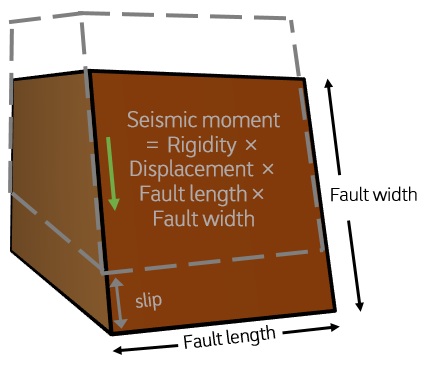
Figure 5 A schematic diagram showing the calculation of seismic moment.
Magnitude and energy
The energy release of an earthquake is proportional to the amplitude to the power of 3⁄2. Each whole number increase in magnitude represents approximately 32-fold ((101.0)3/2) increase in energy, and an increase of two whole number of magnitude represents a 1000-fold ((102.0)3/2) increase in energy. As can be seen from Figure 6, the energy released by an earthquake of magnitude 6 is equivalent to the atomic bomb explosion in Hiroshima. The power of a strong earthquake cannot be underestimated.
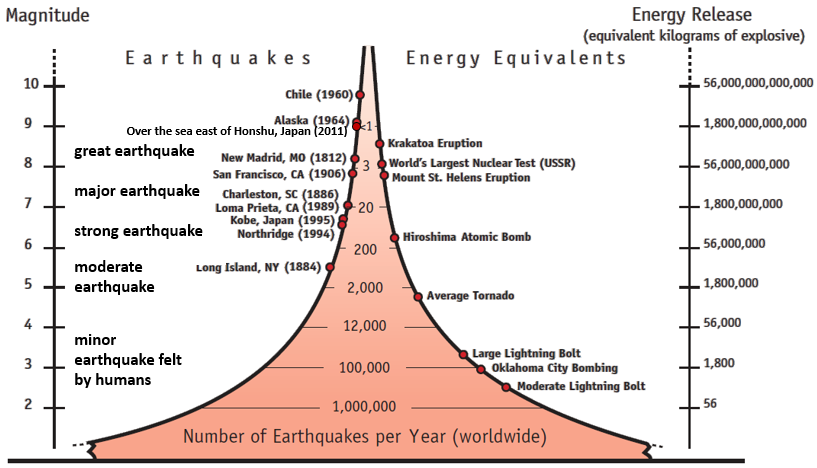
Figure 6 Earthquake magnitudes and energy release, and comparison with other natural and man-made events, as well as the average annual number of earthquakes of different magnitudes in the world. (Source: Incorporated Research Institutes for Seismology (IRIS))
If you look closely at the earthquake reports issued by the Hong Kong Observatory, you may have noticed that Richter Scale has not been mentioned in the earthquake magnitude for quite a long time. In fact, official seismic agencies around the world such as the China Earthquake Administration and the United States Geological Survey (USGS) will refer to all earthquake parameters before deciding on the earthquake magnitude for dissemination instead of always using a specific type of earthquake magnitude so that the size of an earthquake can be described objectively. Moment magnitude, which does not saturate, is generally the preferred choice of most agencies nowadays.
References:
[1] Ammon, C.J., Th. Lay, H. Kanamori & M. Cleveland (2011): A rupture model of the 2011 off the Pacific coast of Tohoku earthquake. Springer Open. Earth, Planets and Space. Vol. 63, Suppl.7.
[2] Bormann, P., S. Wendt, D. DiGiacomo (2013): Seismic Sources and Source Parameters. - In: Bormann, P. (Ed.), New Manual of Seismological Observatory Practice 2 (NMSOP2), Potsdam : Deutsches GeoForschungsZentrum GFZ, 259 pp.
[3] 中國地震局: 中華人民共和國國家標準:地震震級的規定 (GB 17740-2017).
[4] 劉瑞豐、 陳運泰、 任梟、 徐志國、 王曉欣、 鄒立曄 和 張立文 (2015): 震級的測定. 地震出版社.
[5] Richter C.F. (1958): Elementary Seismology. W H Freeman & Co. 768 pp.
[6] Technophysics (1983): 93, No. 3/4 Kanamori, Magnitude scale and quantification of earthquakes.
[7] United States Geological Survey (USGS) : Earthquake Magnitude, Energy Release, and Shaking Intensity.
[8] USGS: Magnitude Types.
[1] Ammon, C.J., Th. Lay, H. Kanamori & M. Cleveland (2011): A rupture model of the 2011 off the Pacific coast of Tohoku earthquake. Springer Open. Earth, Planets and Space. Vol. 63, Suppl.7.
[2] Bormann, P., S. Wendt, D. DiGiacomo (2013): Seismic Sources and Source Parameters. - In: Bormann, P. (Ed.), New Manual of Seismological Observatory Practice 2 (NMSOP2), Potsdam : Deutsches GeoForschungsZentrum GFZ, 259 pp.
[3] 中國地震局: 中華人民共和國國家標準:地震震級的規定 (GB 17740-2017).
[4] 劉瑞豐、 陳運泰、 任梟、 徐志國、 王曉欣、 鄒立曄 和 張立文 (2015): 震級的測定. 地震出版社.
[5] Richter C.F. (1958): Elementary Seismology. W H Freeman & Co. 768 pp.
[6] Technophysics (1983): 93, No. 3/4 Kanamori, Magnitude scale and quantification of earthquakes.
[7] United States Geological Survey (USGS) : Earthquake Magnitude, Energy Release, and Shaking Intensity.
[8] USGS: Magnitude Types.